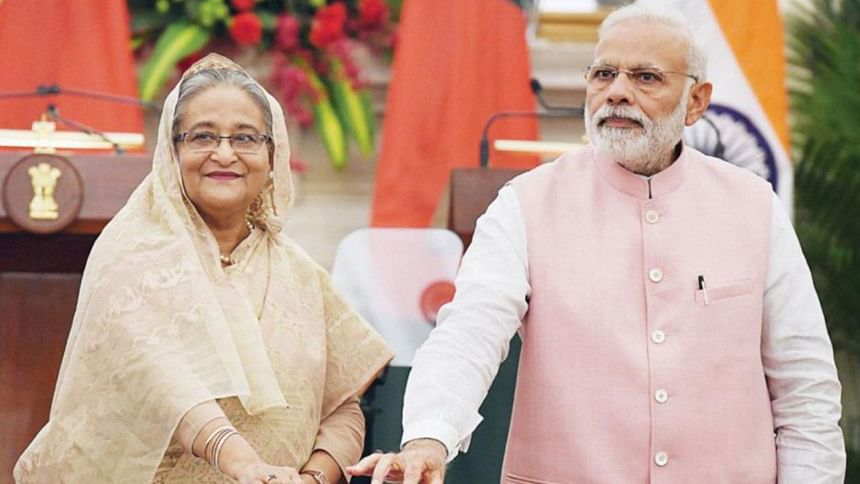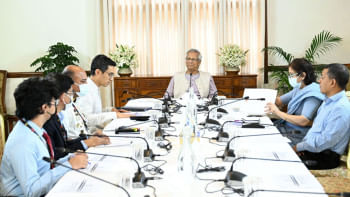IMF growth forecasts for India-Bangladesh: How India should see it

The latest country-wise economic growth projection dished out by the International Monetary Fund (IMF) for financial year 2020-21 has made headlines in India as much for its forecast of a double-digit contraction of the three-trillion-dollar Indian economy, Asia's third largest, as for predicting that Bangladesh would overtake India in terms of US dollar-denominated real per capita GDP. The IMF figures—worse than what the Reserve Bank of India put out recently predicting 9.5 percent shrinking of the GDP—have given rise to much acrimony and heated debate in India. The Indian print media discussed the comparative performance of the two economies, and some commentators questioned whether it is appropriate to measure foreign currency-determined real GDP for a comparative study. It had its political fallout too, providing fresh ammo for the opposition parties to attack Prime Minister Narendra Modi government's handling of the economy.
The criticism of the economic slowdown is nothing new. The Indian economy has been on the decline for the last four years. Now the pandemic has dealt a mighty blow to it adding to the economic woes of the country.
The IMF sees India's per capita GDP (in dollar terms, at current prices) falling to USD 1,877 in 2020, a decline of 10.3 percent, and for Bangladesh, the corresponding figure is seen growing to USD 1,888, a rise of 4 percent. The comparison with Bangladesh in terms of real per capita GDP growth was fodder for the opposition which sought to rub the salt in the wounds by using that fact. Congress leader Rahul Gandhi and Trinamool Congress lawmaker Abhishek Banerjee taunted the Modi government over this. Kaushik Basu, Cornell University's professor of economics and former chief economist of the World Bank, tweeted that IMF's latest projection of Bangladesh's real per capita GDP surpassing India's real per capita GDP—after India had a lead of 25 percent five years ago—is "shocking" and calls for "bold fiscal/monetary policy". He, however, did acknowledge that "any emerging economy doing well is good news."
On the other hand, noted economist Arvind Subramanian, a former chief economic advisor to the government of India under Modi, said in a twitter post that "the IMF's historical numbers are themselves based on countries' local currency GDP estimates which are subject to uncertainty for both India and Bangladesh." He suggests that a "more appropriate basis is GDP at constant prices and purchasing power parity (PPP) exchange rates. This shows India ahead and, despite Covid's more adverse impact in 2020, likely to remain so."
What comes out clearly through the din of the debate over the IMF report on India and Bangladesh's growth forecasts is that the Bangladesh economy has accelerated in the last three years while India's growth story started declining. An article in The Indian Express analysed the causes why Bangladesh has overtaken India in per capita GDP: "It also helps that the structure of Bangladesh's economy is such that its GDP is led by the industrial sector, followed by the services sector. Both these sectors create a lot of jobs and are more remunerative than agriculture. India, on the other hand, has struggled to boost its industrial sector and has far too many people still dependent on agriculture."
In per capita GDP terms, India was significantly above Bangladesh till a few years ago, but the gap has been substantially narrowed owing to Bangladesh's fast-rising low-skilled and labour-intensive export sector. Besides, while India's investments remained lukewarm, the corresponding figures for Bangladesh saw an impressive surge. India's per capita GDP, in US dollar terms, is projected to be USD 1,876.53 in 2020, lower than USD 1,887.97 projected for Bangladesh. However, India's per capita GDP is expected to overtake Bangladesh's per capita GDP in the next financial year with the IMF projecting it to be USD 2,030.62 as against USD 1,989.85 of the latter. However, the trend is not expected to sustain for long as India's per capita GDP is then again expected to slip below Bangladesh's per capita GDP in 2024 to USD 2,544.26 as against USD 2,544.32. It is not for the first time that India has fallen behind Bangladesh by this yardstick. It had done so in early 1990s when the value of US dollar vis-à-vis Indian rupee went up sharply following the devaluation of the Indian currency.
The Modi government countered the opposition onslaught by pointing out that India's GDP in terms of purchasing power parity (PPP) was eleven times more than that of Bangladesh in 2019. Government sources stressed that under the Modi government, India's per capita GDP has increased from Rs 83,091 in 2014-15 to Rs 1,08,620 in 2019-20, representing an increase of 30.7 percent. In PPP terms, India's per capita GDP in 2020 is estimated by IMF at USD 6,284 as compared to USD 5,139 for Bangladesh, according to the sources. Under the second edition (2009-14) of the Congress party-led United Progressive Alliance, it had increased from Rs 65,394 in 2009-10 to Rs 78,348 in 2013-14, which is an increase of 19.8 percent.
What should not be overlooked in this comparison between India and Bangladesh's GDP growth is the fact that Bangladesh's economic rise, particularly in the last decade, has been remarkable, and no attempt should be made to take anything away from that story by resorting to technicalities. Take any yardstick—manufacturing and exports and a range of social development indicators such as fertility, child mortality, literacy, female labour participation, and financial inclusion—and you will find a remarkable transformation story in India's eastern neighbour, prompting Indian politician and economist Subramanian Swamy to say that "Bangladesh is a miracle in the making, offering development lessons for all."
The approach of compare and contrast is fine but more worthwhile is drawing lessons from that. There should not be any attitude of condescension. If Bangladesh is pursuing the right economic policies and benefitting from it, it is important for India to learn from it. Two Indian prime ministers, Manmohan Singh and Narendra Modi, said on separate occasions that India has a keen interest in Bangladesh's economic prosperity and wants Bangladesh's growth story to benefit from India's own development story. The two countries should be plugged into each other's economic growth to draw economic mileage from collaborative efforts.
Pallab Bhattacharya is a special correspondent of The Daily Star. He writes from New Delhi, India.

 For all latest news, follow The Daily Star's Google News channel.
For all latest news, follow The Daily Star's Google News channel. 



Comments